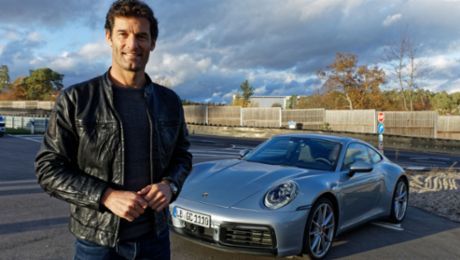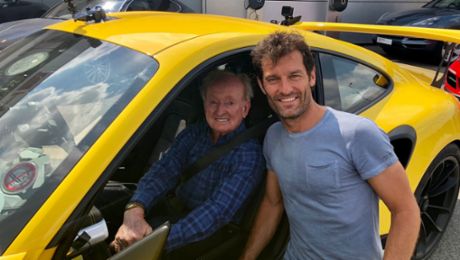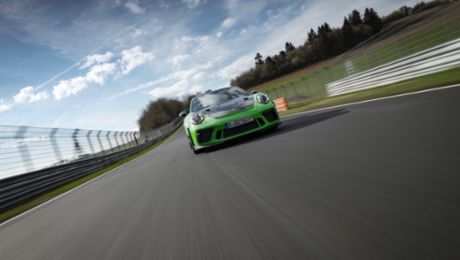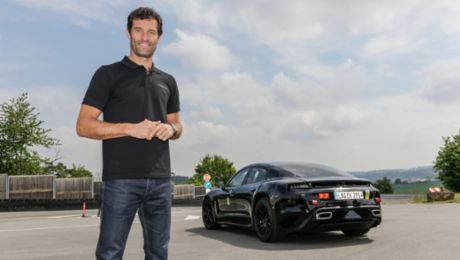The road from Mark Webber’s house, just outside Aylesbury, some 70 kilometers northwest of London, to the Silverstone racetrack is rather dull. You travel mostly in a straight line, and the traffic is always heavy, even when you travel outside rush hour. This circumstance is not encouraging, given it is the only time he has to try the brand-new Boxster Spyder. He is on his way to Silverstone to race his 919 Hybrid in the opening round of the 2015 World Endurance Championship.
Mark takes one look at the car, noting its additional spoilers, new rear deck, and lowered suspension. He knows already it has the 276 kW (375 hp), 3.8-liter motor from the Carrera S behind him. “Wow, it looks just like a Carrera GT’s younger brother,” he says with a huge grin. “I think we’ll go the long way today. Over the years I’ve worked out quite a good route …”
“I’ve always loved the shape of Porsche sports cars”
It might seem strange to say it, but many race-car drivers aren’t that interested in cars: to them they are merely the means by which their talent is expressed and victories achieved. Mark Webber is an exception. He loved Porsches long before he was paid to drive them, and has a fabulous collection, from a 1950s 356 Cabriolet to a 911 GT2 RS (997), all acquired before he became a Porsche factory driver.
“I’ve always loved the shape of Porsche sports cars. I drove my first 911 twenty years ago in Sydney, when I was doing Formula Ford, and I guess I’ve been hooked ever since. More recently I remember doing a track day at Paul Ricard with lots of fast cars and F1 and sports-car drivers. And with us guys driving, one by one they just dropped out, either be-cause their brakes were gone or because something had gone wrong with them. At the end there was just this 997 Turbo S going round with no problem at all. Tells you all you need to know about the way Porsche engineers its cars.”
“This manual is amazing”
We have barely left the village before Mark is eulogizing about the Boxster. “You have to get the basics right. It doesn’t matter how much performance a car has if the driving position is terrible, or the seat doesn’t hold you properly. This is perfect: the wheel is the right size and shape and has no buttons on it. I need them on my 919, but not here. Nothing is more complicated than it needs to be; everything is designed to let you focus on the driving, and that’s what matters.”
So how does this nine-time winner of Formula One races drive? Expertly, quickly, but with no drama at all. He reaches the speed he wants, and then uses the Porsche’s grip and poise to maintain it. Soon I discover why we came this way: the scenery is beautiful, the roads challenging and completely deserted. Once he takes a strange line through a bend that leads over a blind crest, and as I’m wondering why I notice a substantial pothole just over the brow, which he has missed by millimeters. He knows this road as well as the one outside his house.
Mark changes gears so smoothly, you might think the car had a PDK transmission instead of a six-speed manual gearbox, so I ask him which he prefers. “Some people think manual transmissions are out of date, others that paddle-shift boxes take the fun away. I genuinely like both. Obviously, we have to use paddles in the race car, and in a normal road car I’d also choose paddles, unless the manual gearbox was amazing.” Then another huge smile spreads across his face, and he shifts down from fourth to third, momentarily opening the throttle by himself: “And this manual is amazing,” he laughs.
As for the engine, the biggest ever fitted to a Boxster, Mark is as thoughtful as ever, recog-nizing at once that it’s not just about the extra power. “What’s remarkable about taking a Carrera S engine and putting it in the Boxster is the options it gives you. It’ll rev pretty high and gives great power, but because it also has great low-end torque, if you want to drive fast but in a more relaxed manner, you can simply select a higher gear, sit back, and know the engine will still respond as you want at lower revs.”
Silverstone is getting closer now, and, sensing the journey’s end, Mark briefly makes full use of the car’s performance, with the engine howling its approval. It lasts only a few seconds, but it is enough to impress a race-car driver used to being given only the best of the best to drive. “What else can you buy for the same money that can do that?” he exclaims. “This car is quiet and comfortable enough for us to be able to chat all the way here, and then, when you want, provide a level of dynamic involvement that would be pretty rare to find in any car, let alone one as affordable as this.”
The true inspiration for the Boxster Spyder
Our journey is over, but the fun has only just begun. Mark may be here to race his 919 Hybrid, but first, sitting by the test track belonging to the Silverstone-based Porsche Experience Center, is a history lesson on wheels—nothing less than the car that provided the inspiration for the Boxster Spyder.
This Porsche 550 Spyder first made its race debut in 1953, where it won its class at Le Mans. The actual car here is a later 550 A, a visually similar but structurally very different car (it had a space frame rather than a ladder chassis), and identical to the car that claimed Porsche’s very first top-level international competition win, at the Targa Florio in Sicily in 1956. In its mid-engine configuration, with its boxer engine, roadster bodywork, and a focus on providing the purest driving experience possible, it is the true inspiration for the Boxster Spyder.
Silverstone is ideally suited to the 550
Time is short, and Porsche knew the importance of a simple and sound driving environment even sixty years ago, which is why Mark is able to simply climb in and drive the Spyder fast immediately. And it helps that he is one of the world’s best drivers. My happy job is to give chase in the Boxster.
Porsche’s circuit at Silverstone is quite tight, so ideally suited to the 550. Even sitting in the Boxster, I can smell the racing oil in its incredible four-camshaft 1.5-liter engine, and I ex-pect most of Northamptonshire can hear the crackle of its exhaust as Mark starts to work it harder and harder.
I feared that even with Mark Webber driving, I might not have much work to do behind a car so old and with an engine so small, but I soon realized I had underestimated both the car I was following and the man driving it. The 550 A has been prepared to race at Le Mans, and it’s clear from the speed he is driving, the instant gearshifts, and the way he precisely positions the car around the track that Mark is completely comfortable with the car. Lap after lap we go faster and faster, the smooth snarl of the Boxster engine contrasting with the sharp bark of the 550 A motor. Thanks to the power and grip of the Boxster, I can keep up, but I am having to work at it, which is exactly as it should be. We get closer and closer, two open, two-seater, mid-engine Porsche sports cars separated by six decades in time but just centimeters on the track.
“It felt years ahead of its time.”
Too soon our time is up, and Mark heads back to the pits. He’s talking even before he gets out of the car. “That was incredible. I expected it to sound good and even thought it might be quite quick, but the real surprise is how together it feels.”
“If you look at it, you see how well Porsche understood the fundamentals of what makes a great driving machine even then. The car is incredibly light even by modern standards, and putting a boxer engine behind the driver is as good as you can get from the point of view of weight distribution and center of gravity. I loved the gearbox, the engine response, the handling balance, and the whole feel of the car. And it has that sense you get in modern Porsche sports cars that it could go all day, all night, and all the next day and still be ready for more.” What didn’t he like, I ask. “The only area in which the car seems its age is the brakes. The drums don’t slow you much, and the pedal feel is not great either. Other than that, it felt years ahead of its time.”
Someone is calling Mark. He has team meetings before the race, and his time with us is over. Just before he leaves I ask him what else, other than their design similarities, he thinks the cars share. “I guess it’s that Porsche thing of always thinking about the driver, making life easier, so he or she can concentrate on what really matters, which is getting the maximum possible enjoyment from the driving experience. Drive the 550 and the Boxster Spyder, and you’ll know that that focus has been there from the start, and is there, stronger than ever, today.”
New values
The Spyder is the sportiest representative of the Boxster family—both in appearance and in technical terms, as the following figures illustrate.
120
Rear lid: With the two striking streamliners on the aluminum rear lid, the Boxster Spyder tips its hat to the 718 Spyder from the 1960s. The larger rear spoiler extends automatically at 120 km/h.
3.5
Lightweight: With a weight when empty of 1,315 kilograms, the Spyder is the lightest sports car in the Boxster family. The center of gravity is lower than in the other Boxsters, with the power-to-weight ratio down to 3.5 kilograms per horsepower.
2
Appearance: Black Bi-Xenon headlights accentuate a decidedly sporty look.
3
Front apron: The front end, like the rear section, comes from the Cayman GT4. The three large, black-grilled intake ports keep the heat exchangers behind them supplied with cool air.
20
Suspension: The 20-inch wheels specially developed for the Spyder unite lightweight construction with a unique design. Thanks to the sport suspension, the roadster sits 20 millimeters lower.
375
Power train: The 3.8-liter boxer mid-engine breathes through its side air intakes. It puts out 276 kW (375 hp) and comes from the 911 Carrera S.
1
Diffusor: The black rear apron in diffusor look puts the dynamic finishing touch on the tail end. Centrally integrated: the twin tailpipes—sports exhaust system included.
You can find illustrations of the convertible top in the left column.
Info
Text first published in the Porsche customer magazine Christophorus, No. 372
By Andrew Frankel // Photos by Paul Barshon
Consumption data
Boxster Spyder (Typ 981), CO₂ emission (combined): 230 g/km; fuel consumption (combined): 9,9 l/100 km
911 Carrera S (Typ 991), CO₂ emission (combined): 223 (202*) g/km; fuel consumption (combined): 9,5 (8,7*) l/100 km; * with Porsche double-clutch transmission (PDK)
Cayman GT4 (Typ 981), CO₂ emission (combined): 238 g/km; fuel consumption (combined): 10,3 l/100 km





